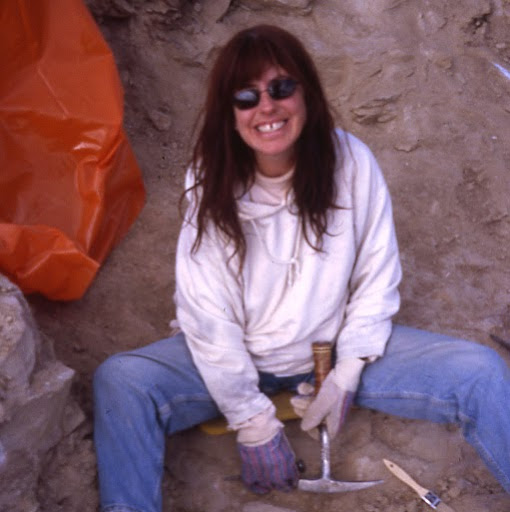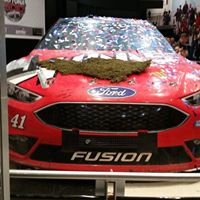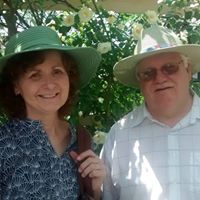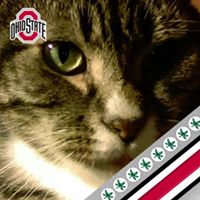Martha A Hayden
age ~81
from Puyallup, WA
- Also known as:
-
- Martha O Hayden
- Martha O'Brien
- Martha O'Hayden
- Phone and address:
- 502 43Rd Ave SE APT 21D, Puyallup, WA 98374
Martha Hayden Phones & Addresses
- 502 43Rd Ave SE APT 21D, Puyallup, WA 98374
- Greer, SC
- West Alexandria, OH
- 10630 148Th St, Renton, WA 98059 • (425)2554812
- 10630 148Th Ave SE, Renton, WA 98059 • (425)2554812
Work
-
Position:Homemaker
Education
-
Degree:High school graduate or higher
Us Patents
-
Expression Vectors Encoding Bispecific Fusion Proteins And Methods Of Producing Biologically Active Bispecific Fusion Proteins In A Mammalian Cell
view source -
US Patent:6482919, Nov 19, 2002
-
Filed:Mar 21, 2001
-
Appl. No.:09/813659
-
Inventors:Jeffrey A. Ledbetter - Seattle WA
Martha S. Hayden - Everett WA
Peter S. Linsley - Seattle WA
Jurgen Bajorath - Everett WA
H. Perry Fell - Redmond WA
Lisa K. Gilliland - Oxford, GB -
Assignee:Bristol-Myers Squibb Company - Princeton NJ
-
International Classification:C07K 1628
-
US Classification:530324, 530350, 5303871, 5303873, 5303879, 530327, 530328, 530329, 530330
-
Abstract:The present invention provides novel soluble CTLA4Ig molecules having modified Ig domains.
-
Modified Sfv Molecules Which Mediate Adhesion Between Cells And Uses Thereof
view source -
US Patent:6699715, Mar 2, 2004
-
Filed:Nov 27, 1996
-
Appl. No.:08/756416
-
Inventors:Jeffrey A. Ledbetter - Seattle WA
Martha Hayden - Everett WA
Perry Fell - Redmond WA
Robert Mittler - Woodinville WA
Gosta Winberg - Bromma, SE -
Assignee:Bristol-Myers Squibb Co. - Princeton NJ
-
International Classification:A61K 39395
-
US Classification:435328, 4241341, 4241351, 435 697, 5303873
-
Abstract:The modified sFv molecules of the present invention stimulate adhesion between cells thereby enhancing the immune response against disease. These molecules generally comprise an antigen binding site of an antibody and at least a portion of a transmembrane domain of a cell surface receptor.
-
Expression Vectors Encoding Bispecific Fusion Proteins And Methods Of Producing Biologically Active Bispecific Fusion Proteins In A Mammalian Cell
view source -
US Patent:7915395, Mar 29, 2011
-
Filed:Oct 29, 2002
-
Appl. No.:10/283610
-
Inventors:Jeffrey A. Ledbetter - Seattle WA, US
Martha S. Hayden - Everett WA, US
Peter S. Linsley - Seattle WA, US
Jurgen Bajorath - Lynnwood WA, US
H. Perry Fell - Redmond WA, US
Lisa K. Gilliland - Oxford, GB -
Assignee:Bristol-Myers Squibb Company - Princeton NJ
-
International Classification:C07H 21/04
C12P 21/06
C12P 21/04 -
US Classification:536 234, 435 691, 435 696
-
Abstract:The present invention provides an expression vector encoding monospecific or bispecific fusion protein. In one embodiment the expression vector encodes a monospecific fusion protein, which vector comprises a recombinant monospecific single chain cassette comprising a DNA sequence encoding a first binding domain capable of binding a cell surface antigen. In another embodiment the expression vector encodes a bispecific fusion protein, which vector comprises a recombinant bispecific single chain cassette comprising a DNA sequence encoding a first binding domain capable of binding a cell surface antigen and a DNA sequence encoding a second binding domain capable of binding a cell surface antigen, each domain capable of binding a different antigen. The present invention also provides a method for producing a biologically active monospecific or bispecific fusion protein in a mammalian cell.
-
Expression Vectors Encoding Bispecific Fusion Proteins And Methods Of Producing Biologically Active Bispecific Fusion Proteins In A Mammalian Cell
view source -
US Patent:61329924, Oct 17, 2000
-
Filed:Oct 5, 1995
-
Appl. No.:8/539436
-
Inventors:Jeffrey A. Ledbetter - Seattle WA
Lisa K. Gilliland - Seattle WA
Martha S. Hayden - San Diego CA
Peter S. Linsley - Seattle WA
Jurgen Bajorath - Everett WA
H. Perry Fell - Redmond WA -
Assignee:Bristol-Myers Squibb Co. - New York NY
-
International Classification:C12P 2102
C12N 1585
C07K 1628 -
US Classification:435 697
-
Abstract:The present invention provides an expression vector encoding monospecific or bispecific fusion protein. In one embodiment the expression vector encodes a monospecific fusion protein, which vector comprises a recombinant monospecific single chain cassette comprising a DNA sequence encoding a first binding domain capable of binding a cell surface antigen. In another embodiment the expression vector encodes a bispecific fusion protein, which vector comprises a recombinant bispecific single chain cassette comprising a DNA sequence encoding a first binding domain capable of binding a cell surface antigen and a DNA sequence encoding a second binding domain capable of binding a cell surface antigen, each domain capable of binding a different antigen. The present invention also provides a method for producing a biologically active monospecific or bispecific fusion protein in a mammalian cell. This method comprises: (a) transfecting the mammalian cell with the recombinant expression vector of the invention; (b) culturing the mammalian cell so transfected in step (a); and (c) recovering the biologically active bispecific fusion protein so as produced by the cultured mammalian cell.
-
Expression Vectors Encoding Bispecific Fusion Proteins And Methods Of Producing Biologically Active Bispecific Fusion Proteins In A Mammalian Cell
view source -
US Patent:56374810, Jun 10, 1997
-
Filed:Sep 13, 1993
-
Appl. No.:8/121054
-
Inventors:Jeffrey A. Ledbetter - Seattle WA
Lisa K. Gilliland - Seattle WA
Martha S. Hayden - San Diego CA
Peter S. Linsley - Seattle WA
Jurgen Bajorath - Everett WA
H. Perry Fell - Redmond WA -
Assignee:Bristol-Myers Squibb Company - New York NY
-
International Classification:C12N 1579
C12N 510
C12P 2100 -
US Classification:435 696
-
Abstract:The present invention provides an expression vector encoding monospecific or bispecific fusion protein. In one embodiment the expression vector encodes a monospecific fusion protein, which vector comprises a recombinant monospecific single chain cassette comprising a DNA sequence encoding a first binding domain capable of binding a cell surface antigen.
-
Expression Of Dna Sequences Encoding A Thermally Stable Cytosine Deaminase From Saccharomyces
view source -
US Patent:53386787, Aug 16, 1994
-
Filed:Jun 1, 1990
-
Appl. No.:7/531646
-
Inventors:Peter D. Senter - Seattle WA
Peter C. D. Su - Mercer Island WA
Hans Marquardt - Mercer Island WA
Martha S. Hayden - Seattle WA
Peter Linsley - Seattle WA -
Assignee:Oncogen, a Limited Partnership - Seattle WA
-
International Classification:C12N 500
C12N 120
C12N 1500
C07H 1512 -
US Classification:435227
-
Abstract:Thermally stable cytosine deaminase (CDase), and the gene coding therefor, is disclosed as well as methods of isolating, purifying, and recombinantly producing the same. The thermally stable CDase can be isolated from Saccharomyces cerevisiae. The yeast isolated enzyme has a molecular weight of approximately 32 kDa, as determined by gel filtration chromatography, and is composed of two subunits, each with a molecular weight of about 17 kDa. Thermally stable yeast CDase so purified shows no significant sequence homology with other known sequenced proteins.
-
Thermally Stable Cytosine Deaminase From Saccharomyces
view source -
US Patent:55455484, Aug 13, 1996
-
Filed:Jun 20, 1994
-
Appl. No.:8/262238
-
Inventors:Peter D. Senter - Seattle WA
Peter C. Su - Mercer Island WA
Hans Marquardt - Mercer Island WA
Martha S. Hayden - Seattle WA
Peter Linsley - Seattle WA -
Assignee:Oncogen - Seattle WA
-
International Classification:C12N 978
-
US Classification:435227
-
Abstract:Thermally stable cytosine deaminase (CDase), and the gene coding therefor, is disclosed as well as methods of isolating, purifying, and recombinantly producing the same. The thermally stable CDase can be isolated from Saccharomyces cerevisiae. The yeast isolated enzyme has a molecular weight of approximately 32 kDa, as determined by gel filtration chromatography, and is composed of two subunits, each with a molecular weight of about 17 kDa. Thermally stable yeast CDase so purified shows no significant sequence homology with other known sequenced proteins.
Resumes

Martha Sue Hayden
view source
Martha Hayden
view source
Martha Hayden
view source
Martha Hayden
view source
Martha Hayden
view sourceWikipedia References

Martha Nessler Hayden
Googleplus

Martha Hayden
Flickr
Classmates

Martha Hayden (Hayden (Ca...
view sourceSchools:
Dublin High School Dublin OH 1971-1975
Community:
Sandra Nothstine

Martha Johnson (Hayden)
view sourceSchools:
Wann High School Wann OK 1959-1963
Community:
Tommy Ryan, Wanda Petty, Jackie Davis, Thomas Reese, Valerie Spaid, Elvin Bailey, Leon Crites, John Sitterly, Wayne Kahre, Lavelma Landrum, Frances Harkins

Martha Hayden | Beloit Me...
view source
Wann High School, Wann, O...
view sourceGraduates:
Martha Hayden (1959-1963),
Lora Anne Bailey (1977-1981),
Elvin Lynn Bailey (1958-1962),
Frank Longpine (1979-1983)
Lora Anne Bailey (1977-1981),
Elvin Lynn Bailey (1958-1962),
Frank Longpine (1979-1983)

Martha Hayden
view source
Martha Hayden
view source
Martha Hayden
view source
Martha Hayden Bedel
view source
Martha Hayden
view source
Martha Hayden
view source
Martha Carpenter Hayden
view source
Martha Hayden
view sourceYoutube
Get Report for Martha A Hayden from Puyallup, WA, age ~81













